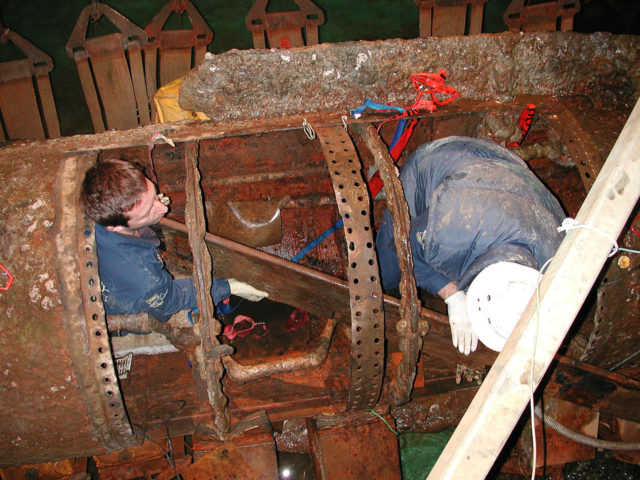Even though the Confederate submarine H.L. Hunley played little part in deciding the outcome of the Civil War, it left behind a legacy of mysteries, some of which are still unanswered and present a tough challenge for researchers.
The Hunley is widely known as the first combat submarine to sink a warship; however, once its successful strike was made, it was lost at sea along with all her eight crewmen on board. The submarine carried the name of its inventor, Horace Lawson Hunley, and was administrated by the Confederate States Army at Charleston, South Carolina.
The Hunley, nearly 40 feet long, had a turbulent history before its final attack. It started operating in July 1863, but the following month sank during a test run, claiming the lives of five people. It was raised and returned to service after that, but then sank again. This time its inventor, who although not a member of the Confederate military was on board the vessel, was among the eight lives lost. While both these times the Hunley was recovered and returned to service, it was not the case when it sank the third time.
Civil War submarine reveals more clues, human remains https://t.co/LKiqmItBUU pic.twitter.com/R3BSEEOOvS
— WTKR News 3 (@WTKR3) June 11, 2017
On February 17, 1864, the Hunley set out to attack and sink the Union side’s screw sloop USS Housatonic, the vessel commissioned to hold the block on Charleston’s outer harbor. The mission was a success, and the Union warship was sent to the sea floor.
Ironically, the submarine also ended sitting on the seabed. There is some evidence that the Hunley survived for an hour after battle. Yet it disappeared, presumably sunk.
The submarine’s remains were located in 1995. After the Hunley was raised in 2000, recovery and conservation work have been ongoing, taking place in North Charleston, South Carolina. Every now and then, the researchers come up with new insights obtained from their extensive examinations of the submarine.
More Human Remains Found In Civil War Confederate Submarine: https://t.co/Nw1SloDI3T from @ATInteresting pic.twitter.com/KovOPSS1eN
— PBH Network (@PBHNetwork) June 9, 2017
Most recently, in June 2017, the researchers released information about the human remains discovered through the conservation work. Reportedly, the researchers finally managed to uncover the crew compartment of the submarine. It had been sealed due to encroached sediment and exposure from the ocean since the time of the Civil War.
Cleaning up the crankshaft that was used to manually propel the vessel yielded some interesting discoveries. In the sediment on the crank holders, a tooth was found that, according to officials, most likely drifted and lodged there as the body of one of the crewmen decomposed. Also studied were the remains of some sort of textile around a small metal wrap found around the hand crank, giving a glimpse into how the crew operated the submarine. Archaeologist Michael Scafuri told CNN affiliate WCIV-TV in Charleston, “When you’re turning an iron bar in front of you, or below you, you’re going to need something to keep your hands from chafing or rubbing them raw.”

Although the new finds provide more insight into how the submarine was run, the biggest mystery of all remains unsolved. What’s the exact reason the Hunley sank after its successful strike?
To answer that, there are several scenarios. According to one of them, the Hunley was hit by a Union vessel trying to rescue the Housatonic. Or the submarine dove to the sea floor in an attempt to avoid being detected, and then never managed to return to the surface.

Reportedly, a latch that was not entirely closed has been found in the forward conning tower of the submarine. As the Hunley‘s weapon would have been attached to a spar, the crew would need to deliver it to the Union warship, and it would then explode. The submarine could have been too close when the torpedo exploded. It is possible that the submarine’s hull was breached at that point. Or the men could have been rendered unconscious due to lack of breathable air, and so unable to get the submarine in motion again.

The human remains found earlier were buried in 2004, but it should also be noted that most human remains were found where the men would have been performing their duties. They were not found, for instance, at an escape hatch.
Hopefully, by then we will have a clearer picture of why the Hunley went down, too.
